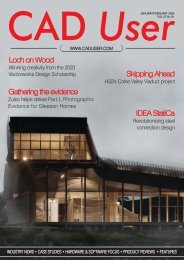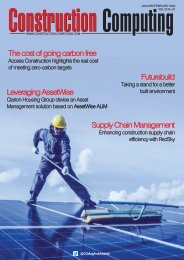Create successful ePaper yourself
Turn your PDF publications into a flip-book with our unique Google optimized e-Paper software.
TECHNOLOGYfocus<br />
4D Planning<br />
4D planning is the process of applying time plans to<br />
3D models, while the output is a visual simulation of a<br />
construction project, writes David Chadwick<br />
Iwas looking through the wrong end of<br />
the telescope when I spoke to David<br />
Simpson, Global Product Manager at<br />
Elecosoft, about 4D planning recently. I<br />
was focused on the project management<br />
side of the business - the use of<br />
consolidated data to provide the<br />
information that Project Managers need to<br />
make strategic decisions. Whilst this is an<br />
obvious benefit, 4D planning leverages<br />
the mass of finer detail contained within<br />
the BIM model to highlight the day-to-day<br />
activities on site, and to recognise and<br />
deal with issues as they occur.<br />
The most effective way of doing this is to<br />
use an all-encompassing 4D planning tool<br />
that can support the creation of scheduled<br />
timings, activate the components of the<br />
3D model to visually simulate the<br />
scheduled sequence, and capture<br />
progress on-site. This as-built data can<br />
then be used to compare scheduled<br />
progress against the original plan. This is<br />
only achievable if the Project Managers<br />
have detailed information on every<br />
element of construction related activity on<br />
the site, and the commencement and<br />
completion of each task.<br />
This, of course, is made simpler with<br />
Elecosoft's Site Progress Mobile, the<br />
application that keeps on-site managers<br />
and personnel fully briefed on their daily<br />
tasks, providing a two-way<br />
communication to iron out local<br />
difficulties, requirements and requests,<br />
and to sign off tasks when they are<br />
completed.<br />
Properly administered 4D planning has<br />
huge benefits. If tasks in a particular trade<br />
fall behind schedule, it becomes<br />
immediately apparent within the<br />
simulation model what other activities will<br />
be jeopardised and which other trades will<br />
be affected. Steps can either be taken to<br />
alleviate the problem, or to utilise the<br />
software's 'what if' capabilities to explore<br />
some alternative strategies to get the<br />
project back on schedule.<br />
Back to the telescope - I assumed that<br />
considerable effort would be needed to<br />
set up 4D planning scenarios, but much<br />
of the hard graft has already been done.<br />
The data to run 4D planning already<br />
exists. The 4D planning process is reliant<br />
on the architect's 3D construction BIM<br />
model, and the daily task allocation for<br />
each of the trades involved is standard<br />
operating procedure, with the resource<br />
scheduler in each category defining the<br />
human resources, activities and materials<br />
to be used for each task, specifying its<br />
duration and enabling its completion to be<br />
signalled back for inclusion within the<br />
single construction model.<br />
There are still some construction<br />
activities that have to be added to the<br />
architect's model, and these relate to<br />
temporary works, the use of construction<br />
plant, the supply of building components<br />
and material and their temporary<br />
disposition on the building site. I did a tour<br />
of the Hinckley Point construction site<br />
recently, and the most prominent features<br />
were the mass of cranes on-site and the<br />
seemingly haphazard storage of materials<br />
waiting to be picked up and used.<br />
I am assured that with 4D planning each<br />
separate and temporary piece of<br />
equipment, and stored components, can<br />
be modelled and included within a 4D<br />
model, and used as required. Cranes, for<br />
instance, would need their arc of<br />
operation and height limitations to be<br />
included as an attribute, as would the time<br />
needed to erect and dismantle them after<br />
they have completed their role.<br />
VIRTUAL LEGO OR A VITAL TOOL?<br />
Watching a building simulation on screen is<br />
certainly fascinating and very impressive for<br />
potential clients, but beyond seeing how<br />
physical progress during its construction<br />
matches that of the simulated model, what<br />
other benefits does 4D planning provide?<br />
Probably the first that comes to mind is the<br />
most obvious - educating the stakeholder.<br />
As David explained to me, using the 4D<br />
model to communicate with the stakeholder<br />
improves and reduces waste throughout<br />
the entire building lifecycle. What is more,<br />
the further upstream 4D is embedded<br />
within the value chain the greater the<br />
returns. For instance, it gives stakeholders<br />
the opportunity to ask questions and factor<br />
in productivity issues, using the 4D model<br />
as a problem solver and layering in other<br />
factors like cost, facilities management and<br />
environmental concerns and simulating<br />
their effect on the whole project timeline.<br />
Adopting this approach facilitates a lean<br />
methodology, refining and cutting<br />
unnecessary costs in the tendering process<br />
and producing more accurate figures.<br />
Because the whole lifecycle process is<br />
centered around BIM, 4D planning<br />
supports Common Data Environment<br />
(CDE) continuity during the construction<br />
phase of a project and its handover and<br />
subsequent occupation and management.<br />
The biggest benefit, though, is that it<br />
provides a focus for site issues, using the<br />
information provided by on-site trades and<br />
their employees using Elecosoft's Site<br />
Progress Mobile. The commencement,<br />
progress and completion of every activity is<br />
recorded and therefore capable of being<br />
simulated in the 4D model. Should the<br />
project fall behind schedule, it will be picked<br />
up in the model, but more importantly, its<br />
impact on related activities will also be<br />
24<br />
<strong>Jan</strong>uary/<strong>Feb</strong>ruary <strong>2022</strong>

















